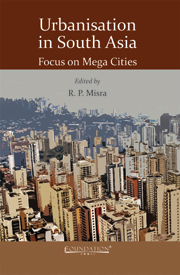Book contents
- Frontmatter
- Contents
- List of Figures
- List of Tables
- List of Contributors
- Introdution
- 1 South Asia: Land, People, and Economy
- 2 Historical Roots of South Asian Urbanisation
- 3 Mumbai: The Financial Capital of India
- 4 Delhi: Growing Problems of a Growing Megalopolis
- 5 Calcutta: The Emergence of Colonial Settlement into Megacity of the East
- 6 Chennai: A Rural Metropolis in Search of Modernity
- 7 Hyderabad: From the Feudal City to a Hi-Tech Metropolis
- 8 Bangalore: From Garden City to Silicon Valley of India
- 9 Karachi: The Commercial Capital of Pakistan
- 10 Lahore: The Cultural Heart of Pakistan
- 11 Kabul: A City in Perpetual Turmoil
- 12 Dhaka: A Mega City of Persistence and Change
- 13 Kathmandu: A City Where Tradition and Modernity Overwhelm Each Other
- 14 Thimphu: The City of Peace and Organic Development
- 15 Colombo: The Primate City of Sri Lanka
- 16 Male: Island Capital of an Island Nation
- 17 Beyond the Present: Vision of a New Urban Future
- Index
16 - Male: Island Capital of an Island Nation
Published online by Cambridge University Press: 05 September 2013
- Frontmatter
- Contents
- List of Figures
- List of Tables
- List of Contributors
- Introdution
- 1 South Asia: Land, People, and Economy
- 2 Historical Roots of South Asian Urbanisation
- 3 Mumbai: The Financial Capital of India
- 4 Delhi: Growing Problems of a Growing Megalopolis
- 5 Calcutta: The Emergence of Colonial Settlement into Megacity of the East
- 6 Chennai: A Rural Metropolis in Search of Modernity
- 7 Hyderabad: From the Feudal City to a Hi-Tech Metropolis
- 8 Bangalore: From Garden City to Silicon Valley of India
- 9 Karachi: The Commercial Capital of Pakistan
- 10 Lahore: The Cultural Heart of Pakistan
- 11 Kabul: A City in Perpetual Turmoil
- 12 Dhaka: A Mega City of Persistence and Change
- 13 Kathmandu: A City Where Tradition and Modernity Overwhelm Each Other
- 14 Thimphu: The City of Peace and Organic Development
- 15 Colombo: The Primate City of Sri Lanka
- 16 Male: Island Capital of an Island Nation
- 17 Beyond the Present: Vision of a New Urban Future
- Index
Summary
Maldives is a nation of approximately 1,190 coral islands, which constitute two lengthy chains running north to south and covering an area of 90,000 sq km. Its Exclusive Economic Zone (EEZ) is spread over 859,000 sq km in the Indian Ocean. Male, the capital of the country has a land area of 2.5 sq km and contains about a third of the population of the country. Only 200 islands are inhabited; most of them have less than 1,000 inhabitants each. Maldives occupies a respectable position in the Asia-Pacific region both in national GDP growth rate, and human development.
Located at 4°10' and 4°.16'67” North latitudes, and 73°30' and 73°.5' East longitudes, Male (pronounced as Maale') is the only island city in the world devoid of mountains, highlands, and rivers. It is a sea-dominated flat land. The surging waves of the sea and lush green vegetation instill natural charm and pristine beauty to it. Male' (Kaafu) Atoll (coral formation) is one of the 20 atoll groups of Maldives (Figure 16.1). It was traditionally the King's Island where the Royal Palace was located and from which the Royal dynasties ruled over the islands. Prior to 1968, it had a fortification wall with entry and exit gates (doroshi) all around. When the city was remodelled by Ibrahim Nasir, the second president of Maldives (1968-1978), the Royal Palace (Gan'duvaru) along with its picturesque forts (kotte) and bastions (buruzu), was demolished.
- Type
- Chapter
- Information
- Urbanisation in South AsiaFocus on Mega Cities, pp. 445 - 457Publisher: Foundation BooksPrint publication year: 2012

